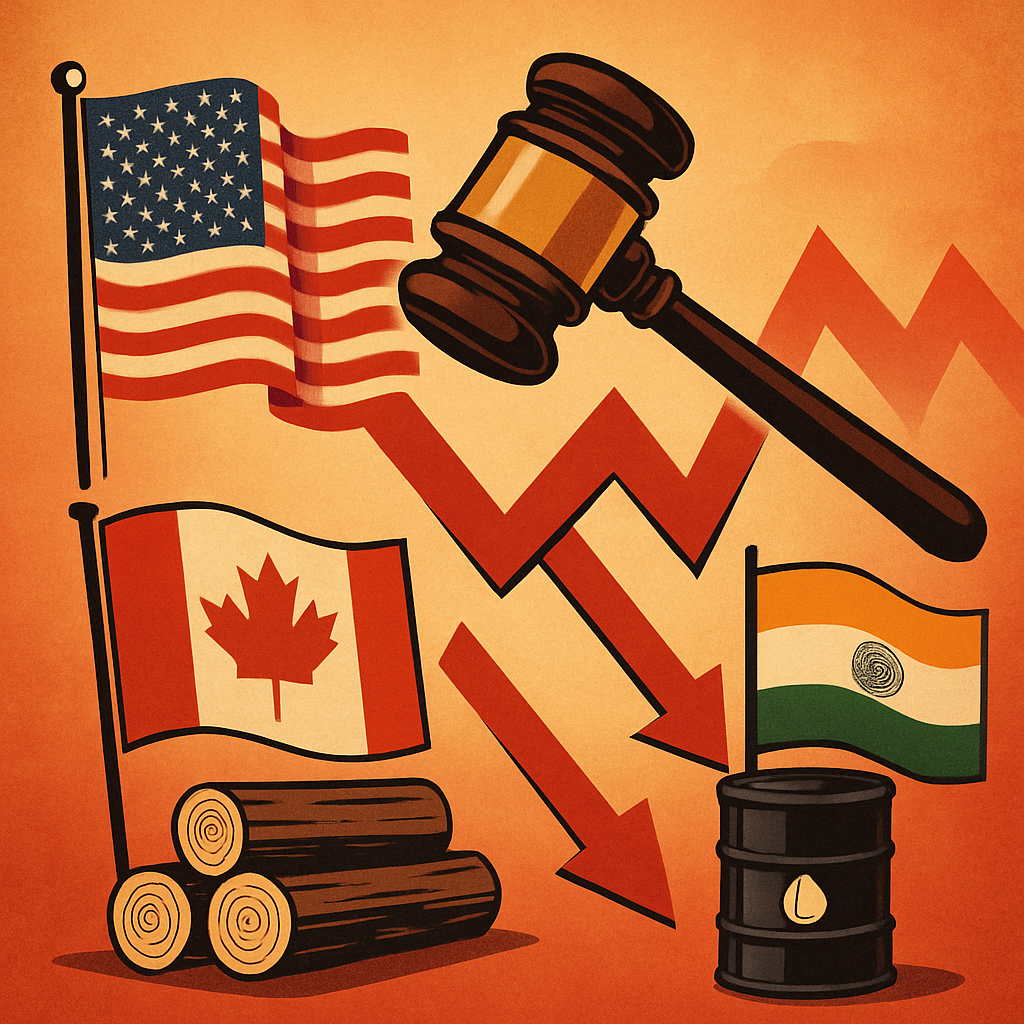As geopolitical risks climb back onto the investor radar, U.S. markets are grappling with the ramifications of a new wave of protectionist policies. President Donald Trump’s latest move—levying steep new tariffs on key trade partners—has sparked fresh uncertainty across global commodity markets and raised red flags for companies exposed to international supply chains.
The U.S. has enacted a 35% tariff on Canadian imports and a 25% tariff on Indian imports of Russian oil, with the White House citing strategic energy security and trade imbalances as justification. However, critics warn that the tariffs risk intensifying inflationary pressure and disrupting the flow of goods at a time when markets are still stabilizing post-pandemic.
Why This Matters for Investors
These tariff actions—confirmed via Reuters and The Guardian Business Live—carry implications well beyond diplomatic headlines. The immediate reaction in commodities markets was telling: crude oil futures rose slightly on supply fears, while the S&P 500 Energy Sector Index saw mild volatility. Meanwhile, shares of Canadian lumber producers and Indian pharmaceutical exporters experienced selling pressure amid expectations of decreased competitiveness in the U.S. market.
U.S. industries that heavily depend on Canadian lumber—especially housing and construction—may face increased input costs. Similarly, India’s role as a refining hub for discounted Russian crude means that U.S. buyers may now turn to pricier alternatives, increasing energy costs downstream.
In the broader macroeconomic picture, these developments further complicate the Federal Reserve’s inflation fight. Higher import costs driven by tariffs could fan inflation expectations just as markets are anticipating a potential rate cut in September. If inflation expectations firm up, the Fed could delay or scale back easing—an outcome that may dampen equities and reignite bond market volatility.
Key Sectors Under Watch
1. Lumber & Construction:
Canada supplies roughly 25% of softwood lumber to the U.S., according to the U.S. Department of Agriculture. A 35% tariff dramatically alters pricing structures. U.S. builders and home improvement companies like Home Depot ($HD) and Lowe’s ($LOW) may pass on rising material costs to consumers or see margin pressure.
2. Auto & Industrial Manufacturing:
Canadian steel, aluminum, and auto components are now more expensive for U.S. manufacturers. Companies like Ford ($F) and General Motors ($GM), which rely on integrated North American supply chains, could see costs creep higher—especially in electric vehicle production.
3. Energy & Refining:
The 25% tariff on Indian imports of Russian oil specifically targets India’s growing trade in discounted barrels. While the move aims to curb indirect flows of Russian oil, it could tighten refined product availability globally. Watch refiners like Valero Energy ($VLO) and Marathon Petroleum ($MPC) as the global crack spread potentially widens.
4. Pharmaceuticals:
India is one of the largest exporters of generic drugs to the U.S. If further tariffs follow, expect ripple effects across U.S. healthcare logistics and pricing. Companies like Teva Pharmaceuticals ($TEVA) or Sun Pharma could be in focus.
Future Trends to Monitor
- Trade Retaliation: Both Canada and India are likely to respond. Investors should monitor retaliatory tariffs, WTO complaints, or alternative trade alliances that could further disrupt supply chains.
- Election-Driven Trade Policy: With the 2026 U.S. midterms looming, trade rhetoric could intensify. Trump’s base often supports protectionist measures, and investors should prepare for more politically motivated economic policy through year-end.
- Inflation Outlook and Fed Response: If tariffs meaningfully push prices higher, the Fed’s September rate cut—widely anticipated by futures markets—could be delayed. Watch CPI prints and Fed commentary closely.
Key Investment Insight
Investors should review exposure to cross-border industries, especially those reliant on Canadian or Indian trade inputs. Defensive portfolio positioning—such as exposure to U.S.-based commodity producers, infrastructure ETFs, or inflation-protected securities (TIPS)—could help hedge against volatility stemming from ongoing tariff escalations.
Additionally, multinationals with flexible supply chains or strong domestic footprints may outperform during periods of heightened trade tension. Consider reviewing sector allocations in light of shifting geopolitical and inflation dynamics.
Stay tuned with MoneyNews.Today as we continue to track the evolving landscape of global trade, political risk, and investment opportunities—delivering timely insights to help you stay ahead of the curve.





